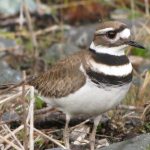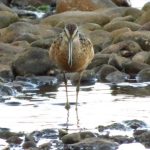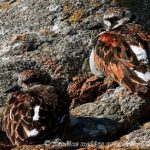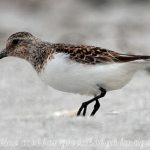
Walking along any of our Island’s beaches, in the early morning, just at daylight at low tide. You can see and hear many of the shorebirds of the Island. The squawk of the great blue heron as it takes flight in the early morning light or sandpipers running up and down the beach with each wave. So take a walk on one of the island’s many beaches. I am sure you will enjoy it.
Black Oystercatcher
 The black oystercatcher eats a variety of invertebrates including mussels, whelks, clams, worms, and limpets. It especially likes to eat creatures that cling to the rocks below the high tide line. They usually feed at low tide. It uses its long, sharp bill to pry bivalves like limpets and mussels off the rocks and then open them. Read More….
The black oystercatcher eats a variety of invertebrates including mussels, whelks, clams, worms, and limpets. It especially likes to eat creatures that cling to the rocks below the high tide line. They usually feed at low tide. It uses its long, sharp bill to pry bivalves like limpets and mussels off the rocks and then open them. Read More….
Black Turnstone
 The Black Turnstone is a common sight on the Pacific coast. The pattern of its plumage makes it quite invisible while foraging on the rocky shores or when flying above the rough seas. Its name refers to its ability to flip over objects to get at foods like algae, hard-shelled invertebrates, and other crustaceans below. Read More….
The Black Turnstone is a common sight on the Pacific coast. The pattern of its plumage makes it quite invisible while foraging on the rocky shores or when flying above the rough seas. Its name refers to its ability to flip over objects to get at foods like algae, hard-shelled invertebrates, and other crustaceans below. Read More….
Great Blue Heron
 The Great Blue Heron resides along lakes, ponds, rivers, and marshes from coastal B.C. all the way to Mexico. This adaptable bird’s large size enables it to prey on a variety of animals including fish, mice, small birds, and insects. This wide variety of feed enables the heron to stay farther north during the winter months, longer than other species. Read More….
The Great Blue Heron resides along lakes, ponds, rivers, and marshes from coastal B.C. all the way to Mexico. This adaptable bird’s large size enables it to prey on a variety of animals including fish, mice, small birds, and insects. This wide variety of feed enables the heron to stay farther north during the winter months, longer than other species. Read More….
Killdeer
 The Killdeer is a noisy plover with black and white breast stripes. Reddish back. It can be found in fields, stony dry areas as well as around water. The killdeer is a medium-sized plover. Adults have a brown back and wings, a white belly, and a white breast with two black bands. The rump is tawny orange. The face and cap are brown with a white forehead. They have an orange-red eye-ring. Read More….
The Killdeer is a noisy plover with black and white breast stripes. Reddish back. It can be found in fields, stony dry areas as well as around water. The killdeer is a medium-sized plover. Adults have a brown back and wings, a white belly, and a white breast with two black bands. The rump is tawny orange. The face and cap are brown with a white forehead. They have an orange-red eye-ring. Read More….
Lesser Yellowlegs
 The Lesser Yellowlegs and its cousin the Greater Yellowlegs look quite similar, but there are a few easy ways to tell them apart, the Lesser Yellowlegs are only about half the weight of his cousin. The bill of the Greater Yellowlegs will turn gray around the base during the non-breeding season while the Lesser Yellowlegs’ bill stays black year-round. Read More….
The Lesser Yellowlegs and its cousin the Greater Yellowlegs look quite similar, but there are a few easy ways to tell them apart, the Lesser Yellowlegs are only about half the weight of his cousin. The bill of the Greater Yellowlegs will turn gray around the base during the non-breeding season while the Lesser Yellowlegs’ bill stays black year-round. Read More….
Long-Billed Dowitcher
 There are many Long-Billed Dowitchers that visit the Pacific Northwest and outer islands during the summer months. This bird is very similar in appearance to the short-billed Dowitcher. Both birds are medium to large shorebirds. In breeding plumage, they are reddish underneath and mottled brown above. Read More….
There are many Long-Billed Dowitchers that visit the Pacific Northwest and outer islands during the summer months. This bird is very similar in appearance to the short-billed Dowitcher. Both birds are medium to large shorebirds. In breeding plumage, they are reddish underneath and mottled brown above. Read More….
Pacific Golden Plover
 Pacific Golden Plover migrates, feeds, and roosts in large flocks, usually up to 50, but can be in much larger flocks when food is plentiful. These golden plovers breed in Alaska in June and July. Males usually return to the same nest site, even to the same spot. Read More….
Pacific Golden Plover migrates, feeds, and roosts in large flocks, usually up to 50, but can be in much larger flocks when food is plentiful. These golden plovers breed in Alaska in June and July. Males usually return to the same nest site, even to the same spot. Read More….
Ruddy Turnstone
 The Ruddy Turnstone is not common on the Pacific Northwest Coast but does visit here, and it’s always a thrill to see them on the beach. The ruddy turnstone is a wading bird with a wedge-shaped bill and fairly short orange legs. The back and wings are gray-brown with black mottling. The head is brownish with white streaks. Read More….
The Ruddy Turnstone is not common on the Pacific Northwest Coast but does visit here, and it’s always a thrill to see them on the beach. The ruddy turnstone is a wading bird with a wedge-shaped bill and fairly short orange legs. The back and wings are gray-brown with black mottling. The head is brownish with white streaks. Read More….
Sanderling
 Sanderlings nest on dry, rocky tundra in the high Arctic usually close to water. The nest is ground-based, in a shallow scrape up on a high spot, and lined with vegetation. The female generally lays a clutch of 4 eggs. The eggs will hatch in about 24 to 31 days and the young will fledge at about 17 days. Read More….
Sanderlings nest on dry, rocky tundra in the high Arctic usually close to water. The nest is ground-based, in a shallow scrape up on a high spot, and lined with vegetation. The female generally lays a clutch of 4 eggs. The eggs will hatch in about 24 to 31 days and the young will fledge at about 17 days. Read More….
Sandhill Cranes
 Sandhill Cranes are comparable in size and shape to the great blue heron, and although they are similar, the two species can be told apart by head colouring and posture. The forehead of the sandhill crane has a red patch of unfeathered skin. Read More….
Sandhill Cranes are comparable in size and shape to the great blue heron, and although they are similar, the two species can be told apart by head colouring and posture. The forehead of the sandhill crane has a red patch of unfeathered skin. Read More….
Spotted Sandpiper
 The Spotted Sandpiper is around 17 cm long. During breeding, it has dark bars of brown above and heavy round, black spots below, the bill is pink at the base and its legs are pinky-orange. It turns pale gray-brown with white underparts in the fall and winter. Read More….
The Spotted Sandpiper is around 17 cm long. During breeding, it has dark bars of brown above and heavy round, black spots below, the bill is pink at the base and its legs are pinky-orange. It turns pale gray-brown with white underparts in the fall and winter. Read More….
Wilsons Snipe
 The Wilsons Snipe is a medium-sized wader, about 28 cm. It is easily identified by its mottled brown back, long, straight bill, and orange tail markings. Other field marks include a whitish belly, blackhead stripes, and dull green legs. Read More….
The Wilsons Snipe is a medium-sized wader, about 28 cm. It is easily identified by its mottled brown back, long, straight bill, and orange tail markings. Other field marks include a whitish belly, blackhead stripes, and dull green legs. Read More….

Take some time to wander around the shores of various types of waterways and keep your eyes open, and you just might see some very beautiful birds. Vancouver Island has many shorebirds, all are fascinating to observe. An estimated two million shorebirds migrate annually through our area too and from their breeding grounds in the Arctic, many more breed and nest in our area. Some species fly for days without rest or food and travel thousands of km to reach their breeding grounds. They arrive at the island in the spring and leave in the fall. Take a walk anywhere on the island, and you will see many of these birds.
Shorebirds frequent estuaries, small offshore islands, and coastal dunes, you can see them on all of Vancouver Island. They must have food, protection from predators, and roosting areas that are conveniently close to their feeding sites to be able to breed, generally at or above the high tide mark. Shorebird breeding and feeding areas are often in the same areas where people like to go hiking or have a picnic, swim, or fish, so we must take care to not disturb these birds, each time these birds are disturbed, they take flight, they burn up energy that is needed for caretaking the young and migrating to their winter grounds.
May I use your image of the spotted sandpiper to paint? I am a local artist in Snohomish County. I love the colors you caught in your background.
You bet Robina.
Thank you. I will send you an image. I appreciate it!